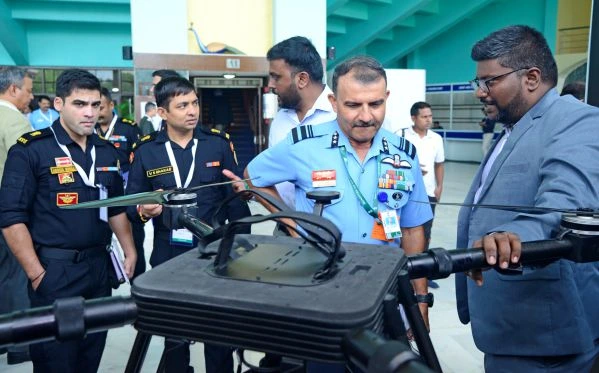Unmanned Aerial Systems India 2023 is being organised on 28 Aug 2023 to include the whole range of unmanned, unattended and remotely controlled or autonomous vehicles for military uses. An overview is given below.
Recent Developments
Indian Armed Forces are looking at procurement of 30 x HALEs, may be in a phased manner to meet the strategic requirements, while efforts are on to build an indigenous pseudo satellite for the same.
Under the Make-II category of acquisition, the Indian Army has granted an Approval In-Principle (AIP) for Integrated Drone Detection and Interdictions System, a feasibility is underway for Autonomous – Surveillance And Armed Drone Swarm (Desert/plains) {A-SADS(desert/ plains) and Autonomous – Surveillance And Armed Drone Swarm High Altitude Area {A-SADS (HAA)}. Acceptance of Necessity (AoN) has been granted for 35 Drone Kill Systems worth INR 78.36 crore for Indian Army in 2021 under Make-II.
Naval Ship Borne Unmanned Aerial System (NSUAS) and HALE UAV have been identified under Make-I and Special Purpose Vehicles (SPV) model for development respectively.
In August 2022, Bharat Electronics Limited (BEL) issued a tender to procure two (2) mini drones with Global Navigation Satellite System (GLONASS).




Military Applications of UAVs.
Some of the important uses include:
• Information, Surveillance, Target Acquisition, and Reconnaissance (ISTAR).
• Unmanned combat aerial vehicles (UCAV).
• Radar and Communication Relay.
• Mapping Military Logistics.
• Nuclear Cloud Surveillance.
Armed Drones. ADE has completed the development of the Rustom-2 TAPAS (Tactical Airborne Platform for Aerial Surveillance) MALE UAV (a MQ-1 category drone). HAL will soon start the production of first five units of TAPAS drones.
In total 76 units of this UAV will be ordered by forces. There will be 60 drones for Indian Army, 12 for the Indian Air Force and 4 for the Indian Navy.
Drone Technology
What information technology was in the 90s, drone technology is today. Technologies that the nation needs to invest in, are:
• Powertrain Technology – Brushless Direct Current (BLDC) Motor.
• Powertrain Technology – Fuel-Run Motor
• Powertrain Technology – Electronics
• Flight Controller
• Battery Technology
• Datalink Technology
• Making Bandwidth Available For Civilian Use
Some emerging technologies have the potential to enhancing effectiveness of drones, viz,
(a) Artificial Intelligence.
(b) Internet of Things (IoT).
Indian Air Force
A Combat Air Teaming System (CATS) is a planned unmanned and manned combat aircraft air teaming system being developed by HAL, which is of interest to the IAF. An armed stealth drone will team up and fight alongside IAF fighters to hit high-value enemy targets. It is designed to carry out MUM-T Operations.
The Unmanned Wingman will be connected to a heavily upgraded IAF Jaguar fighter bomber.
HAL is designing & developing AI powered, stealthy autonomous swarm drones known as ALFA-S
DRDO is developing the Ghatak which is an UCAV for the IAF. The Aura UCAV will be a tactical stealth aircraft capable of delivering laser-guided strike weapons.
Indian Army
The army’s existing unmanned systems’ fleet comprises Heron medium-altitude, long-endurance (MALE) UAVs, and the smaller Searcher Mark II tactical drones.
The Army plans to buy high-tech unmanned aerial vehicles (UAVs) to strengthen its intelligence, surveillance and reconnaissance (ISR) capabilities and improve the effectiveness of its military operations.
Indian Navy
The Indian Navy currently operates Israeli-origin Heron and Searcher Mk-II UAVs, but neither is shipborne. It also has Sea Guardian drones on lease.
The Indian Navy announced its plans, in June 2022, to acquire 40 Naval Unmanned Aerial Systems (NUAS) for more than 100 meters long warships.
Research & Development
DRDO tested, in early-July 2022, the Autonomous Flying Wing Technology Demonstrator, which is a major step ahead of developing unmanned aerial combat vehicles (UCAV), primarily for the Indian Air Force.
Countering Drones
Drones are hard to detect, do not have a significant visual, radar, infra-red or noise signature, and require minimal infrastructure to launch and control. Drones are best countered by effective jamming and laser systems.
DRDO’s D-4 anti-drone system can provide both “soft kill” (jamming of hostile drones) and “hard kill” (a laser-based destruction method) options to the military to tackle fast-emerging aerial threats. It has been used for VIP protection on National Days’ events.
Adani Defence & Aerospace has linked with DRDO and Israel’s Elbit Systems to begin deploying counter-UAS equipment in some of the country’s major airports.
UAV Industry
The union government made a serious paradigm shift in the drone industry by announcing ‘Drone Shakti’ in Budget 2022. Finance Minister Nirmala Sitharaman emphasized that the initiative will also help establish Drones-As-A-Service. With ‘drone as a service’ the government says start-ups will be promoted to facilitate ‘Drone Shakti’ through various use cases and applications.
According to the Civil Aviation Minister, by 2026, the Indian drone industry will achieve a turnover of over Rs 15,000 crore. India is home to 270 startups in the drone technologies business. He has stated that the country will be a global leader in drones by 2030.
The government announced the Production-Linked Incentive scheme on 16 Sep 2021 which provides for funding 20 per cent of the “value addition” made by the company during the next three years.
By 2025, India is forecasted to be the world’s third-largest drone market. The Government of India is planning to make India a Global Drone Hub by 2030, and expects total turnover of the drone manufacturing industry to increase from ₹ 60-80 crore to ₹ 900 crore by FY 2024.

















